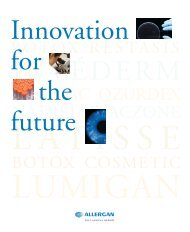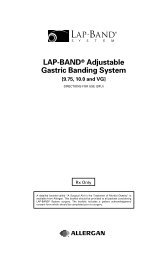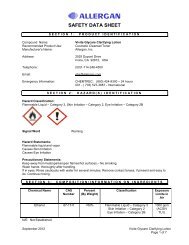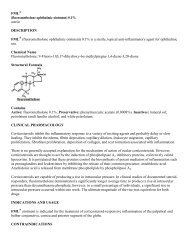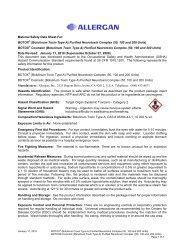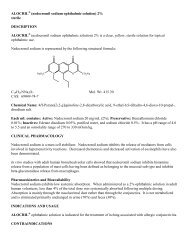BLEPH®-10 Prescribing Information - Allergan
BLEPH®-10 Prescribing Information - Allergan
BLEPH®-10 Prescribing Information - Allergan
- No tags were found...
You also want an ePaper? Increase the reach of your titles
YUMPU automatically turns print PDFs into web optimized ePapers that Google loves.
BLEPH ® -<strong>10</strong>(sulfacetamide sodium ophthalmic solution, USP) <strong>10</strong>%DESCRIPTIONBLEPH ® -<strong>10</strong> (sulfacetamide sodium ophthalmic solution, USP) <strong>10</strong>% is a sterile, topical anti-bacterial agent forophthalmic use. The active ingredient is represented by the following structural formula:Chemical Name: N-Sulfanilylacetamide monosodium salt monohydrate.Contains: Active: sulfacetamide sodium <strong>10</strong>% (<strong>10</strong>0 mg/mL)Preservative: benzalkonium chloride 0.005%lnactives: edetate disodium; polysorbate 80; polyvinyl alcohol 1.4%; purified water; sodium phosphate dibasic;sodium phosphate monobasic; sodium thiosulfate; hydrochloric acid and/or sodium hydroxide to adjust pH (6.8to 7.5).CLINICAL PHARMACOLOGYMicrobiology: The sulfonamides are bacteriostatic agents and the spectrum of activity is similar for all.Sulfonamides inhibit bacterial synthesis of dihydrofolic acid by preventing the condensation of the pteridinewith aminobenzoic acid through competitive inhibition of the enzyme dihydropteroate synthetase. Resistantstrains have altered dihydropteroate synthetase with reduced affinity for sulfonamides or produce increasedquantities of aminobenzoic acid.Topically applied sulfonamides are considered active against susceptible strains of the following commonbacterial eye pathogens: Escherichia coli, Staphylococcus aureus, Streptococcus pneumoniae, Streptococcus(viridans group), Haemophilus influenzae, Klebsiella species, and Enterobacter species.Topically applied sulfonamides do not provide adequate coverage against Neisseria species, Serratiamarcescens and Pseudomonas aeruginosa. A significant percentage of staphylococcal isolates are completelyresistant to sulfa drugs.INDICATIONS AND USAGEBLEPH ® -<strong>10</strong> solution is indicated for the treatment of conjunctivitis and other superficial ocular infections dueto susceptible microorganisms, and as an adjunctive in systemic sulfonamide therapy of trachoma: Escherichiacoli, Staphylococcus aureus, Streptococcus pneumoniae, Streptococcus (viridans group), Haemophilusinfluenzae, Klebsiella species, and Enterobacter species.Topically applied sulfonamides do not provide adequate coverage against Neisseria species, Serratiamarcescens and Pseudomonas aeruginosa. A significant percentage of staphylococcal isolates are completelyresistant to sulfa drugs.CONTRAINDICATIONS
BLEPH ® -<strong>10</strong> solution is contraindicated in individuals who have a hypersensitivity to sulfonamides or to anyingredient of the preparation.WARNINGSFOR TOPICAL EYE USE ONLY - NOT FOR INJECTION.FATALITIES HAVE OCCURRED, ALTHOUGH RARELY, DUE TO SEVERE REACTIONS TOSULFONAMIDES INCLUDING STEVENS-JOHNSON SYNDROME, TOXIC EPIDERMALNECROLYSIS, FULMINANT HEPATIC NECROSIS, AGRANULOCYTOSIS, APLASTIC ANEMIA ANDOTHER BLOOD DYSCRASIAS. Sensitizations may recur when a sulfonamide is readministered, irrespectiveof the route of administration. Sensitivity reactions have been reported in individuals with no prior history ofsulfonamide hypersensitivity. At the first sign of hypersensitivity, skin rash or other serious reaction,discontinue use of this preparation.PRECAUTIONSGeneralProlonged use of topical anti-bacterial agents may give rise to overgrowth of nonsusceptible organismsincluding fungi. Bacterial resistance to sulfonamides may also develop.The effectiveness of sulfonamides may be reduced by the para-aminobenzoic acid present in purulent exudates.Sensitization may recur when a sulfonamide is readministered irrespective of the route of administration, andcross-sensitivity between different sulfonamides may occur.At the first sign of hypersensitivity, increase in purulent discharge, or aggravation of inflammation or pain, thepatient should discontinue use of the medication and consult a physician (see WARNINGS).<strong>Information</strong> for PatientsTo avoid contamination, do not touch tip of container to the eye, eyelid or any surface.Drug InteractionsSulfacetamide preparations are incompatible with silver preparations.Carcinogenesis, Mutagenesis, Impairment of FertilityNo studies have been conducted in animals or in humans to evaluate the possibility of these effects withocularly administered sulfacetamide. Rats appear to be especially susceptible to the goitrogenic effects ofsulfonamides, and long-term oral administration of sulfonamides has resulted in thyroid malignancies in theseanimals.PregnancyPregnancy Category C.Animal reproduction studies have not been conducted with sulfonamide ophthalmic preparations. Kernicterusmay occur in the newborn as a result of treatment of a pregnant woman at term with orally administeredsulfonamides. There are no adequate and well controlled studies of sulfonamide ophthalmic preparations inpregnant women and it is not known whether topically applied sulfonamides can cause fetal harm whenadministered to a pregnant woman. This product should be used in pregnancy only if the potential benefitjustifies the potential risk to the fetus.Nursing MothersSystemically administered sulfonamides are capable of producing kernicterus in infants of lactating women.
Because of the potential for the development of kernicterus in neonates, a decision should be made whether todiscontinue nursing or discontinue the drug taking into account the importance of the drug to the mother.Pediatric UseSafety and effectiveness in infants below the age of two months have not been established.ADVERSE REACTIONSBacterial and fungal corneal ulcers have developed during treatment with sulfonamide ophthalmic preparations.The most frequently reported reactions are local irritation, stinging and burning. Less commonly reportedreactions include non-specific conjunctivitis, conjunctival hyperemia, secondary infections and allergicreactions.Fatalities have occurred, although rarely, due to severe reactions to sulfonamides including Stevens-Johnsonsyndrome, toxic epidermal necrolysis, fulminant hepatic necrosis, agranulocytosis, aplastic anemia, and otherblood dyscrasias (see WARNINGS).DOSAGE AND ADMINISTRATIONFor conjunctivitis and other superficial ocular infections: Instill one or two drops into the conjunctivalsac(s) of the affected eye(s) every two to three hours initially. Dosages may be tapered by increasing the timeinterval between doses as the condition responds. The usual duration of treatment is seven to ten days.For trachoma: Instill two drops into the conjunctival sac(s) of the affected eye(s) every two hours. Topicaladministration must be accompanied by systemic administration.HOW SUPPLIEDBLEPH ® -<strong>10</strong> (sulfacetamide sodium ophthalmic solution, USP) <strong>10</strong>% is supplied sterile in opaque white LDPEplastic bottles and white dropper tips with white high impact polystyrene (HIPS) caps as follows:5 mL in <strong>10</strong> mL bottle - NDC 11980-011-05Storage: Store at 8°-25°C (46°-77°F). Protect from light. Sulfonamide solutions, on long standing, will darkenin color and should be discarded.Revised: 05/2014© 2014 <strong>Allergan</strong>, Inc.Irvine, CA 92612, U.S.A.® marks owned by <strong>Allergan</strong>, Inc.Made in the U.S.A.71736US13





